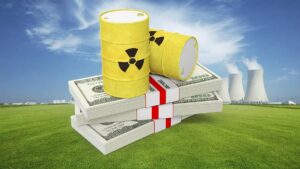Aura Energy unveils plan to boost Tiris uranium production, improve economics

Aura Energy’s increased production target will also deliver improved economics for its Tiris uranium project. Pic: Getty Images
- Aura Energy has increased the production target for its Tiris uranium project by 44% to 43.5Mlbs U3O8 over the life of mine, which has increased to 25 years
- NPV upgraded by 29% to US$499m while IRR is up from 34% to 39%
- Life of mine cash flows increased by 42% to US$1.5bn while payback has dropped from 2.5 years to 2.25 years
Special Report: Expanded resources at the Tiris uranium project in Mauritania have allowed Aura Energy to deliver a corresponding increase in its production target by 44% to 43.5Mlbs U3O8 over the life of mine.
Shareholders reacted positively to the news today, with the stock rallying nearly 5%.
This has increased the mine life from the original 17 years contemplated in the February 2024 front end engineering design (FEED) study to 25 years using the existing 91.3Mlb resource, which was upgraded by 55% in June this year.
Importantly for Aura Energy (ASX:AEE), the decision has significantly improved project economics with post-tax net present value (NPV) increased by 29% to US$499m ($734m) while IRR has climbed from 34% to 39%.
Post-tax life of mine cash flow has increased by 42% to US$1.5bn while payback will occur a couple of months earlier, improving from 2.5 years to 2.25 years.
“The updated economics from the production target update clearly show the very significant value inherent at Tiris as Aura Energy rapidly progress towards the funding and development of the project,” managing director Andrew Grove said.
“The US$4.5 million drilling program undertaken earlier this year not only delivered a 55% increase in mineral resources but has also demonstrated over US$100 million of additional project NPV, now standing at US$499 million.
“It is our strong belief that there is still very significant potential to continue to add to the mineral resource and reserve inventory around Tiris East and across the whole northern Mauritanian region, within the 13,000km2 of tenements that Aura has under application.”
He added that the updated production target study has not only increased mine life and improved project economics, it also simplified and de-risked the early mining sequence and brought forward some uranium production by 21% in the first year, and by 9% over the first five year compared to the FEED study.
“These improved metrics will further support the funding process, which is currently underway with indicative offers due this quarter.”
Modular design providing opportunities
The increase in production target is testament to the modular circuit design for Tiris, which enables flexibility in production scheduling and potential for rapid and simple expansion of production capacity.
AEE notes that there is significant potential to expand production capacity early in the project life cycle to more effectively use the existing resource estimate.
While the FEED estimated initial capex at US$230m to enable a production capacity of 2Mlbs per annum U3O8, increasing output to 2.8Mlbs per annum or 3.5Mlbs per annum would require expansion capital of US$83m or US$166m respectively.
Next steps
The company is currently focused on securing project funding, which could include contributions from debt, strategic investors and equity options.
It will also seek to secure further offtake contracts, adding to its existing deal with experienced uranium trader Curzon Uranium, which was recently revised to ensure that the company receives more for its produced uranium.
Other work includes starting drilling to confirm water infrastructure for future operations, engagement with EPCM (engineering, procurement and construction management) contractors for project development, and additional engineering and design work to support development.
AEE will also seek to update ore reserve estimate at Tiris, analyse options for future project growth, complete the project execution plan and make a final investment decision in Q1 2025.
This article was developed in collaboration with Aura Energy, a Stockhead advertiser at the time of publishing.
This article does not constitute financial product advice. You should consider obtaining independent advice before making any financial decisions.
Related Topics

UNLOCK INSIGHTS
Discover the untold stories of emerging ASX stocks.
Daily news and expert analysis, it's free to subscribe.
By proceeding, you confirm you understand that we handle personal information in accordance with our Privacy Policy.








